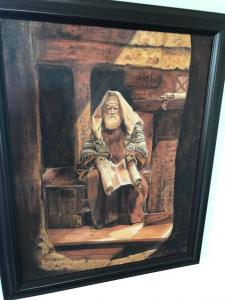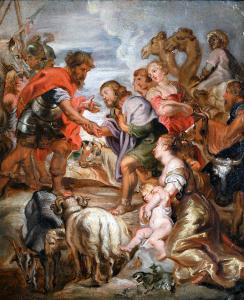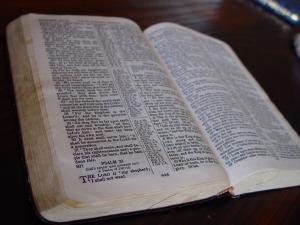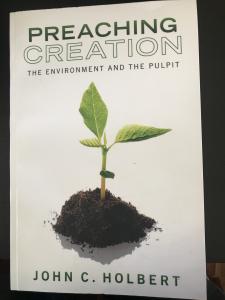 I have no idea what happened to him, but a portrait he painted rests on my wall some forty years later; I am looking at it right now, still amazed at what I am seeing. In 1980, I was in the second semester of my first class in Introduction to the Old Testament, as we called it in those days, with perhaps 30 students in attendance. I was a brash 34- year-old know-it-all, who tried in every way possible to offer vast freedoms to my students, to liberate them from the shackles of the usual lecture-quizzes-final exam classroom demands of their other fuddy-duddy subjects. So, in that spirit of “anything goes” I told them for a final assignment I would allow them to do any one of several things to fulfill the course requirements. If they just could not stand such freedom, I would set a final exam for them in the traditional style, but if they were feeling frisky, and some surely were, I said they could “write a poem, create a short story, compose a song, or paint a picture,” based on a brief exegesis of a biblical passage that they had selected from somewhere in the Hebrew Bible, and turn it in to me on the assigned date of the final exam.
I have no idea what happened to him, but a portrait he painted rests on my wall some forty years later; I am looking at it right now, still amazed at what I am seeing. In 1980, I was in the second semester of my first class in Introduction to the Old Testament, as we called it in those days, with perhaps 30 students in attendance. I was a brash 34- year-old know-it-all, who tried in every way possible to offer vast freedoms to my students, to liberate them from the shackles of the usual lecture-quizzes-final exam classroom demands of their other fuddy-duddy subjects. So, in that spirit of “anything goes” I told them for a final assignment I would allow them to do any one of several things to fulfill the course requirements. If they just could not stand such freedom, I would set a final exam for them in the traditional style, but if they were feeling frisky, and some surely were, I said they could “write a poem, create a short story, compose a song, or paint a picture,” based on a brief exegesis of a biblical passage that they had selected from somewhere in the Hebrew Bible, and turn it in to me on the assigned date of the final exam.
Well over half the class rushed to the front after that announcement to clarify what I had meant by this peculiar series of possibilities. Most of the ones who came up were the class leaders, the ones who had regularly felt comfortable speaking in class. However, among their number was a large, imposing man from Oklahoma, far taller than me, with wide shoulders, a colorful shirt, a ten-gallon hat that he had worn each day to class, a bright silver belt buckle on his wide leather belt, encompassing a spreading girth that threatened to explode over that straining belt. He waited until all the others had spoken, and then sauntered up to me and said, “I think I would like to paint a picture.” Those may have been the first words he had spoken in our class together. Well, I thought in my deeply smug mind, I have loosed the bands of disaster now; this “Okie” will provide some kind of stick-figure drawing, loosely based on some text or other, and I will be forced to evaluate it, not knowing quite what to say. “Ok, Tom,” I replied, “Have at it.” And he left.
When the day arrived for the class to turn in their assignments, I admit that the interceding 40 years have wiped my memory clean of all the other student works, all the poems (mostly doggerel, I fear, as I dimly recall), all the stories, all the songs. But Tom’s portrait of the prophet Jeremiah still brings to me that initial feeling of awe when I first saw it. It was, and is, a stunning portrayal of the imprisoned prophet, grimly and sadly holding a scroll containing the deed to a land purchase that he made during the Babylonian siege of Jerusalem around 587-86 BCE. I looked at that portrait amazed by its exquisite detail, its subtle shadings, its genuine capture of a man whose prophetic life had been filled with failure and torment and hatred from his enemies, but who still knew that he had spoken faithfully for YHWH, his God. The look on his face, the slump of his shoulders, spoke loudly of the wonder and the horror of what it meant to be a prophet of God.
Tom’s exegesis on the passage from Jeremiah 32 was excellent, and the painting was magical. I have never assigned an easier A-grade to any assignment in my 36-year teaching career. When I gave it back to Tom some days later, I asked him what he planned to do with his work. “Oh,” he said shyly, “I guess I will just put it under my bed, or something.” “Could I have it then?” I quickly asked. “Sure,” said Tom, “if you want it, but let me build you a frame for it first.” And he did, and it immediately found its way onto the walls of my office, and then after retirement, the walls of of our Dallas house, and now it rests prominently just to the right of where I write, upstairs from our small, 3- room “ Garage Mahal,” in LA where I can eye it searchingly and lovingly. I am very sorry, and somewhat ashamed to say that I have lost track of Tom. I do not know if he ever pastored a church, ever served any sort of ministry, ever painted another picture. I hope someday to find out these things.
What leads me to reflect on Tom’s work now four decades old is the recent spate of appalling and disheartening assaults on persons of color primarily if not exclusively by white people in our nation. Just this week, 8 persons, six of whom were Asian-American, were murdered by a 21-year-old white man in three Atlanta area spas, who claimed that his sex addiction had driven him to the foul act in the attempt to remove his temptations, terrible lures that his very religious upbringing had told him were the worst sort of unforgiveable sins. The combination of racial hatred, ethnic contempt, religious demands, and gun violence is another example of the monstrous stew of outrage and pain that fester in our land among too many of our citizens. This man objectified these women as both “other” and “lures,” somehow responsible for his problems, problems he could not, would not, address as fully his own. However one finally understands the fuller range of factors that led this man to murder 8 innocent people, it can certainly be said that he chose his victims because he saw them as other than he, as persons who had mostly looked different. In short, their appearance drew his attention and his murderous actions.
I did not expect my student Tom to be able to produce anything like the Jeremiah portrait that he created, because I had already decided that such a person as Tom never could do such a thing; he was a “good ole’ boy” from Oklahoma, and by definition then could never be a sensitive and skilled artist. I had made my decision about his “gifts” based on my preconceived notions about who I thought he was. Is that foolish and reckless activity not at the base of so much of the horrifying racism that we experience in US America today? Black people are inferior, incapable of doing so much of what they can do; hence we predetermine that they are to be relegated to a lower caste than we whites. Asian-American women are “petite, cute, exotic,” so they must be playthings of my powerful and male whiteness, objects of my lurid desires. They surely could never serve as doctors or lawyers or professors. My predeterminations, based on ignorant and bigoted ideas of how certain people may be understood, can lead to monstrous deeds of oppression and abuse at worst, subversion and avoidance at best. The assessment of appearances is crucial as we navigate the diverse world we all inhabit.
The teller of the tale of Jacob and Esau in Genesis 25-33 is a prime example based on a reader’s too-rash assessment of just who in the story may be representative of the presence and care of YHWH. Jacob appears to the hero, and when he bests his twin brother, tricking him out of the elder’s birthright and blessing, we laugh at the foolishness of Esau, who would rather eat a bowl of stew than remain heir of the promise of his father, Isaac, would rather serve up the game requested by that same father than permit his tricky brother to beat him to the post by giving the old man the food first. When Esau howls his rage as Jacob flees for Haran, we chortle with glee at the fool’s fury. However, when that same Jacob meets a mysterious man at the Jabbok river, wrestles with him, and then claims that he has wrestled with God, the reader wonders whether he has in fact met God or has rather met himself, struggling with himself, attempting to discover a truth he has yet to find. That insight is made all the more possible when he then meets brother Esau, after the passage of 20 years, with Esau rushing down a mountainside, apparently seeking vengeance on that scheming Jacob. But instead in a powerful reversal Esau grabs his brother in a great hug and forgives him for everything previously done! It is Jacob who announces that seeing Esau’s face is just like seeing the face of YHWH. Both we and Jacob realize that we have judged Esau poorly, inadequately, and have evaluated him incorrectly. As I did with Tom, as the Atlanta murderer did with the Asian-American women, so did Jacob with his brother.
In Acts 10:34, Luke gives to us one of the Bible’s great claims, a claim that serves as a theological axiom for much of the New Testament. Peter, we are told, begins his speech to the Roman centurion, Cornelius, “In truth, I am grasping that God is no respecter of appearances.” This is a translation, rooted firmly in the Greek text, offered by Luke Timothy Johnson in his 1992 commentary on Acts. It is Johnson’s way of presenting the core of the idea that no extraneous factors ought ever lead us to sway fair judgment. Such “impartiality” is attributed to God directly in the Greek reading of Deut.10:17, a God “who is not partial and takes no bribes.” Also, at 2 Kings 3:14, the phrase used means a preference for one person over another. Romans 2:11, Colossians 3:25, Ephesians 6:9, I Peter 1:17, James 2:1,9 all say the same; no sort of appearance should ever force us to choose one person or group over another. My own prejudice, however benign it may have been with regard to my student, is on the same continuum as the deep bigotry of any committed racists, led to that position by a false evaluation of appearances. I look at Tom’s portrait of Jeremiah and am reminded again that God is no respecter of appearances, and neither must I ever be.
(Images from Wikimedia Commons and my personal collection)











